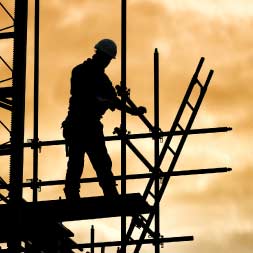Scaffolding Safety is a temporary structure used to
support a work crew and materials to aid in the construction, maintenance and
repair of buildings, bridges and all other man made structure. Scaffolds are
widely used on site to get access to heights and areas that would be otherwise
hard to get to. Unsafe scaffolding has the potential to result in death or
serious injury.
There are Eight Types of Scaffolding –
- Single Scaffolding
- Double Scaffolding
- Trestle Scaffolding
- Steel Scaffolding
- Patented Scaffolding
- Suspended Scaffolding
- Cantilever Scaffolding
- Kwikstage Scaffolding
Working on related scaffolding can be very dangerous
whenever the proper safety precautions are not maintained. However, when the
safety protocols and practices, are observed properly, working on these
structures can be just as safe as any other elevated construction technique.
While working in Scaffolding, you can control the Hazards
by following these methods –
DO’s
- Inspect the scaffold using a checklist or mobile inspection app before the work shift and ensure it is safe and in proper working order.
- Have a toolbox talk before beginning work.
- Wear appropriate PPE.
- Always check inspection tags.
- Know the weight capacity of the scaffold.
- Have a handhold above the scaffold platform.
- Level the scaffold after each move. Do not extend adjusting leg screws more than 12 inches.
- Use your safety belts and lanyards when working on scaffolding at a height of 10 feet or more above ground level. Attach the lanyard to a secure member of the scaffold.
- Safely use the ladder when climbing the cross braces for access to the scaffold.
- Keep both feet on the decking.
- Stay off scaffold during loading or unloading.
- Ensure planking is overlapping or secured from movement.
- Follow the manufacturer’s instructions when erecting the scaffold, under the direct supervision of a competent person.
- Chock the wheels of the rolling scaffold, using the wheel blocks, and also lock the wheels by using your foot to depress the wheel-lock, before using the scaffold.
- Always use netting to catch anything that falls.
DON’T’s
- Leave anything on the scaffold at the end of your shift.
- Overload the scaffold.
- Use unstable objects such as barrels, boxes, loose brick or concrete blocks to support scaffolds, increase your work height or planks.
- Work on platforms or scaffolds unless they are fully planked.
- Use a scaffold unless guardrails and all flooring are in place.
- Stand on ties, guardrails, or extensions.
- Use the scaffold if it appears damaged in any way, has been tampered with, or if there are components missing such as planking, guardrails, toeboards, debris nets or protective canopies.
- Walk on scaffold planking covered in ice, snow or mud.
- Avoid using a scaffold during adverse weather such as heavy rain, sleet, ice snow or strong winds.
- Climb on any portion of the scaffold frame not intended for climbing.
- Never climb with any materials or tools in your hand, they should be hoisted up to the scaffold separately.
- Jump from, to, or between scaffolding.
- Rock the scaffold.
- Throw anything “overboard” unless a spotter is available.
- Move a mobile scaffold if anyone is on it.
Guidelines in Tagging
Scaffold –
Scaffold tags are
used to protect the lives of your workers. It identifies if a scaffold is safe
or unsafe for use. Follow the guidelines below when tagging scaffolds.
v Inspection and
tagging of the scaffold are to be performed by a competent person experienced
in the erection of scaffold.
v A unique scaffold
identification tag number must be clearly identified on all tags for tracking
purposes.
v All scaffolds shall
be inspected after the erection per regulatory requirements.
v All scaffold
identification tags will be of a solid green, yellow, or red color with black
lettering.
It is common practice
to use the following color schemes: Green, Yellow, Red
·
Green –
tags will be hung on scaffolds that have been inspected and are safe for use. A
green “SAFE FOR USE” tag(s), and should be attached to the scaffold at each access
point after the initial inspection is complete.
·
Yellow –
“CAUTION” tag(s), will replace all green “Safe Scaffold” tag(s) whenever the
scaffold has been modified to meet work requirements, and as a result, could
present a hazard to the user. This tag indicates special requirements for safe
use.
NOTE:
Use of the “yellow tag” status is not intended to override the green tag system. All efforts should be
made to return the scaffold to a “Green Tag” status as soon as possible.
·
Red –
“DANGER – UNSAFE FOR USE” tag(s), will be used during erection or dismantling
when the scaffold is left unattended and replace all green “Safe for Use ”
tag(s) or yellow “Caution / Hazard “ tag(s) in the event a scaffold has been
deemed unfit for use.
Send us your enquiry
to info@thesafetymaster.com or speak to our expert at +917665231743
for conducting Scaffolding Safety Training Certificate Course in the workplace.




No comments:
Post a Comment